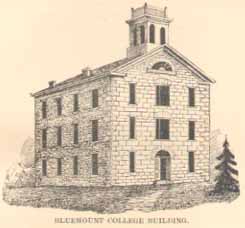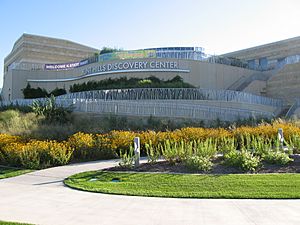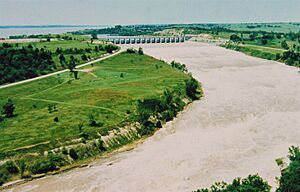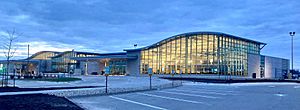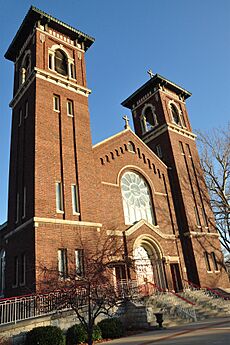Manhattan, Kansas facts for kids
Quick facts for kids
Manhattan, Kansas
|
||
|---|---|---|
|
City and County seat
|
||

Riley County Courthouse (2005)
|
||
|
||
| Nickname(s):
The Little Apple, MHK
|
||

Location within Riley County and Kansas
|
||
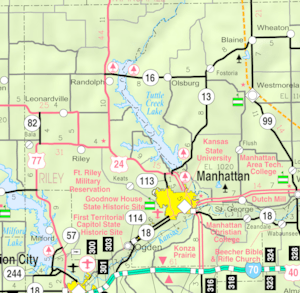
|
||
| Country | United States | |
| State | Kansas | |
| Counties | Riley, Pottawatomie | |
| Founded | 1855 | |
| Incorporated | 1857 | |
| Government | ||
| • Type | Commission-Manager | |
| Area | ||
| • City and County seat | 19.91 sq mi (51.56 km2) | |
| • Land | 19.85 sq mi (51.40 km2) | |
| • Water | 0.06 sq mi (0.16 km2) | |
| • Metro | 18.88 sq mi (48.89 km2) | |
| Elevation | 1,056 ft (322 m) | |
| Population
(2020)
|
||
| • City and County seat | 53,900 | |
| • Density | 2,707/sq mi (1,045.4/km2) | |
| Time zone | UTC−6 (CST) | |
| • Summer (DST) | UTC−5 (CDT) | |
| ZIP Codes |
66502–66503, 66505–66506
|
|
| Area code | 785 | |
| FIPS code | 20-44250 | |
| GNIS ID | 485618 | |
Manhattan is a city in Kansas, United States. It is the main city of Riley County, Kansas, but also reaches into Pottawatomie County. The city is in northeastern Kansas where the Kansas River and Big Blue River meet. In 2020, about 54,100 people lived there.
Manhattan was started in the 1850s by settlers who wanted Kansas to be a "Free-State" (meaning no slavery). This was during a time called Bleeding Kansas. The city is often called "the Little Apple" because it sounds like New York City's nickname, "the Big Apple". Manhattan is also home to Kansas State University, which gives the city a lively college town feel.
History of Manhattan, Kansas
Early Native American Settlements
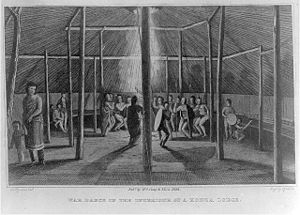
Before European-Americans settled here in the 1850s, Native American tribes lived on the land around Manhattan. From 1780 to 1830, the Kaw people, also known as the Kansa, called this area home. Their village was named Blue Earth Village. It was near where the Big Blue River met the Kansas River. A big battle between the Kaw and Pawnee tribes happened here in 1812.
The Kaw tribe gave up their ownership of this land in a treaty signed in 1846.
How Manhattan Was Founded
In 1854, the Kansas–Nebraska Act allowed U.S. citizens to settle in this territory. That fall, George S. Park started the first European-American settlement here, calling it Polistra. Later that year, Samuel D. Houston and other pioneers started a nearby community called Canton. Neither of these small settlements grew very much.
In March 1855, a group of Free-Staters from New England came to Kansas. They wanted to create a town where slavery was not allowed. Led by Isaac Goodnow, they chose the spot where Polistra and Canton were located. In April 1855, these New Englanders joined with the people from Canton and Polistra to form one settlement named Boston.
In June 1855, a paddle steamer called the Hartford got stuck in the Kansas River near the settlement. This boat was carrying 75 settlers from Ohio. They had planned to go further up the river to where Junction City is now. Since they were stranded, the Hartford passengers decided to join the new town. But they insisted it be renamed Manhattan. This happened on June 29, 1855. Manhattan officially became a city on May 30, 1857.
Important Early Events
Early settlers in Manhattan sometimes had conflicts with Native tribes. The town was also threatened by people who supported slavery. Manhattan was strongly against slavery. It even elected the only two Free-State lawmakers to the first Territorial Legislature. Luckily, nearby Fort Riley protected the town from the worst violence of the "Bleeding Kansas" era. This helped Manhattan grow quickly.
On January 30, 1858, Manhattan was named the county seat for Riley County. Ten days later, on February 9, 1858, a Methodist college called Blue Mont Central College was started in Manhattan.
The city got another boost in 1859 when gold was found in the Rocky Mountains. Many people, called Fifty-Niners, traveled through Manhattan on their way to find gold. Manhattan was one of the last big towns on the route west. Its shops did good business selling supplies to the miners. Manhattan's first newspaper, The Kansas Express, started on May 21, 1859.
In 1861, when Kansas became a state, Isaac Goodnow worked to turn Blue Mont Central College into the state university. On February 16, 1863, the Kansas legislature created Kansas State Agricultural College (now Kansas State University) in Manhattan. When the college opened on September 2, 1863, it was the first public college in Kansas. It was also the first land-grant university in the country and one of the first public colleges to admit both women and men equally.
By 1866, when the Kansas Pacific Railroad built tracks through Manhattan, the town was well-established. Manhattan's population has grown every ten years since it was founded. In 1952, Manhattan received the All-America City Award, the first city in Kansas to get it.
Geography and Natural Features
Manhattan is located at 39.1836082, -96.5716694. It is in the beautiful Flint Hills and Great Plains of Kansas. This is about 50 miles (80 km) west of Topeka on the Kansas River.
The city covers about 18.79 square miles (48.67 km2). Most of this is land, with a small amount of water.
What are the Geographic Features?

Manhattan is in the Flint Hills region of Kansas. This area has rolling hills covered in tall grasses. However, the downtown area of Manhattan was built on a flat area where the Kansas and Big Blue rivers meet. Manhattan is the biggest town in the Flint Hills. It is home to the Flint Hills Discovery Center, which teaches about this unique area.
Tuttle Creek Reservoir is about 5 miles (8 km) north of Manhattan. This lake was created in the 1960s when the Big Blue River was dammed to control floods. It is now a state park with many fun activities. South of the city is the Konza Prairie. This is a preserve for tallgrass prairie owned by The Nature Conservancy and Kansas State University.
Earthquakes in Kansas?
Kansas is not known for many earthquakes. But Manhattan is near the Nemaha Ridge, which is a long structure with several active faults. The Humboldt Fault Zone is only about 12 miles (19 km) east of Tuttle Creek Reservoir.
On April 24, 1867, a 5.1 magnitude earthquake hit Riley County near Manhattan. It is still the strongest earthquake to start in Kansas. It caused minor damage in Kansas, Iowa, and Missouri.
Even though Kansas doesn't have many earthquakes, a strong one could be a problem. If a big earthquake happened along the Nemaha Ridge before 2010, it could have damaged the dam at Tuttle Creek Reservoir. This could have released a lot of water and flooded nearby areas, threatening thousands of people and homes. To prevent this, the Army Corps of Engineers finished a project in 2010. They replaced sand under the dam with concrete walls and added sensors. These sensors would warn people if an earthquake happened.
Manhattan's Climate
Manhattan has a humid continental climate. This means it has hot, humid summers and cold, dry winters. The average temperature in January is about 29.1°F (-1.6°C) and in July it's about 80.0°F (26.7°C). Temperatures reach 90°F (32°C) about 59 days a year and 100°F (38°C) about 10 days a year. It gets to 0°F (-18°C) or colder about 4 days a year. The hottest temperature ever recorded was 116°F (47°C) in August 1936. The coldest was -35°F (-37°C) in February 1899.
Manhattan gets about 35.77 inches (908.6 mm) of rain each year. Most of this rain falls from May to August. It snows about 8.8 days a year, with 5.6 days getting at least 1 inch (2.5 cm) of snow.
| Climate data for Manhattan, Kansas, 1991–2020 normals, extremes 1893–present | |||||||||||||
|---|---|---|---|---|---|---|---|---|---|---|---|---|---|
| Month | Jan | Feb | Mar | Apr | May | Jun | Jul | Aug | Sep | Oct | Nov | Dec | Year |
| Record high °F (°C) | 75 (24) |
84 (29) |
95 (35) |
99 (37) |
103 (39) |
112 (44) |
115 (46) |
116 (47) |
112 (44) |
98 (37) |
90 (32) |
77 (25) |
116 (47) |
| Mean maximum °F (°C) | 63.9 (17.7) |
70.8 (21.6) |
80.8 (27.1) |
87.8 (31.0) |
92.8 (33.8) |
97.6 (36.4) |
102.9 (39.4) |
101.6 (38.7) |
96.6 (35.9) |
89.6 (32.0) |
75.1 (23.9) |
65.2 (18.4) |
104.4 (40.2) |
| Mean daily maximum °F (°C) | 39.6 (4.2) |
45.1 (7.3) |
56.3 (13.5) |
66.4 (19.1) |
75.9 (24.4) |
85.8 (29.9) |
90.8 (32.7) |
89.0 (31.7) |
81.3 (27.4) |
69.1 (20.6) |
54.6 (12.6) |
43.0 (6.1) |
66.4 (19.1) |
| Daily mean °F (°C) | 29.1 (−1.6) |
33.6 (0.9) |
43.9 (6.6) |
54.3 (12.4) |
65.0 (18.3) |
75.1 (23.9) |
80.0 (26.7) |
77.7 (25.4) |
69.2 (20.7) |
56.6 (13.7) |
43.2 (6.2) |
32.7 (0.4) |
55.0 (12.8) |
| Mean daily minimum °F (°C) | 18.7 (−7.4) |
22.1 (−5.5) |
31.5 (−0.3) |
42.2 (5.7) |
54.1 (12.3) |
64.3 (17.9) |
69.3 (20.7) |
66.4 (19.1) |
57.1 (13.9) |
44.1 (6.7) |
31.8 (−0.1) |
22.5 (−5.3) |
43.7 (6.5) |
| Mean minimum °F (°C) | −1.4 (−18.6) |
3.4 (−15.9) |
12.6 (−10.8) |
25.9 (−3.4) |
37.1 (2.8) |
49.8 (9.9) |
56.8 (13.8) |
54.2 (12.3) |
39.9 (4.4) |
25.9 (−3.4) |
14.8 (−9.6) |
3.9 (−15.6) |
−4.7 (−20.4) |
| Record low °F (°C) | −31 (−35) |
−35 (−37) |
−12 (−24) |
5 (−15) |
23 (−5) |
39 (4) |
45 (7) |
40 (4) |
26 (−3) |
13 (−11) |
−9 (−23) |
−22 (−30) |
−35 (−37) |
| Average precipitation inches (mm) | 0.64 (16) |
1.14 (29) |
2.17 (55) |
3.38 (86) |
5.23 (133) |
5.47 (139) |
4.62 (117) |
4.40 (112) |
3.41 (87) |
2.50 (64) |
1.62 (41) |
1.19 (30) |
35.77 (909) |
| Average snowfall inches (cm) | 4.8 (12) |
5.0 (13) |
1.8 (4.6) |
0.1 (0.25) |
0.0 (0.0) |
0.0 (0.0) |
0.0 (0.0) |
0.0 (0.0) |
0.0 (0.0) |
0.0 (0.0) |
1.1 (2.8) |
4.8 (12) |
17.6 (44.65) |
| Average precipitation days (≥ 0.01 in) | 5.2 | 5.6 | 8.2 | 10.4 | 12.9 | 10.8 | 9.9 | 10.7 | 8.4 | 8.1 | 6.4 | 5.4 | 102.0 |
| Average snowy days (≥ 0.1 in) | 2.5 | 2.3 | 1.0 | 0.1 | 0.0 | 0.0 | 0.0 | 0.0 | 0.0 | 0.1 | 0.6 | 2.2 | 8.8 |
| Source 1: NOAA | |||||||||||||
| Source 2: National Weather Service | |||||||||||||
Tornadoes in Manhattan
Kansas is in an area often called Tornado Alley. The strongest tornado to hit Manhattan happened on June 11, 2008, around 10:30 PM. This powerful EF4 tornado destroyed 31 homes and several businesses. Kansas State University's campus had about $20 million in damage. Luckily, no one was killed.
Before that, the most damaging tornado was on June 8, 1966. The 1966 tornado caused $5 million in damage and injured at least 65 people in Manhattan.
Flooding Challenges
Manhattan was built on a flat area where the Kansas and Big Blue rivers meet. Because of this, it has often had problems with flooding from heavy rain. The worst floods were in 1903, 1908, the Great Flood of 1951, and the Great Flood of 1993.
In 2019, record rainfall caused water levels to rise greatly. Tuttle Creek Reservoir reached its second-highest flood level ever on May 31, 2019. The only time it was higher was during The Great Flood of 1993. The emergency gates of the Tuttle Creek Spillway have only been opened once, on July 19, 1993. This allowed a huge amount of water to flow through to prevent worse flooding.
Population and People
| Historical population | |||
|---|---|---|---|
| Census | Pop. | %± | |
| 1870 | 1,173 | — | |
| 1880 | 2,105 | 79.5% | |
| 1890 | 3,004 | 42.7% | |
| 1900 | 3,438 | 14.4% | |
| 1910 | 5,722 | 66.4% | |
| 1920 | 7,989 | 39.6% | |
| 1930 | 10,136 | 26.9% | |
| 1940 | 11,659 | 15.0% | |
| 1950 | 19,056 | 63.4% | |
| 1960 | 22,993 | 20.7% | |
| 1970 | 27,575 | 19.9% | |
| 1980 | 32,644 | 18.4% | |
| 1990 | 37,712 | 15.5% | |
| 2000 | 44,831 | 18.9% | |
| 2010 | 52,281 | 16.6% | |
| 2020 | 54,100 | 3.5% | |
| U.S. Decennial Census 2010-2020 |
|||
Manhattan is the main city of the Manhattan metropolitan area. In 2014, this area had about 98,091 people. It is also part of the larger Manhattan-Junction City area, which had an estimated population of 134,804 in 2014. This makes it the fourth largest urban area in Kansas.
What Does the 2020 Census Tell Us?
The 2020 United States census counted 54,100 people living in Manhattan. There were 21,414 households and 9,995 families. The population density was about 2,715.6 people per square mile (1,048.5/km2).
Most of the people (76.05%) were white. About 5.91% were black, 5.32% were Asian, and 0.52% were Native American. About 9.21% of the population was Hispanic or Latino.
About 16.5% of residents were under 18 years old. A large part of the population (32.6%) was between 18 and 24 years old, likely due to the university. The average age was 25.4 years.
Economy and Jobs
Manhattan's economy relies a lot on the public sector. Kansas State University is the biggest employer in the city. Its nearly 24,000 students help support local shops and entertainment. The city's school district is the second-largest employer.
Many people who work at nearby Fort Riley, including over 3,500 civilian employees, live in Manhattan and support its economy. Also, most of the 150 employees of the Kansas Department of Agriculture work in Manhattan. Their office is next to the National Bio and Agro-Defense Facility (NBAF).
Large private companies in Manhattan include Ascension Via Christi Hospitals, CivicPlus, and Farm Bureau. Manhattan also has some manufacturing and commercial businesses. These include GTM Sportswear, Florence Corporation, Manko Windows, Parker Hannifin, and Farrar Corporation.
Education in Manhattan
Colleges and Universities
Kansas State University is the largest employer and school in Manhattan. It has almost 24,000 students. KSU is known for its Wildcat sports teams and its strong academic programs. It has been ranked first nationally among state universities for its number of important scholars since 1986.
Manhattan is also home to other colleges like Manhattan Christian College, Manhattan Area Technical College, and the American Institute of Baking.
Schools for Younger Students
Most of Manhattan is part of the Manhattan-Ogden USD 383 public school district. This district has one public high school (Manhattan High School), two middle schools, and nine elementary schools.
The city also has two private school systems: Flint Hills Christian School (for Preschool through 12th grade) and the Manhattan Catholic Schools. Manhattan Catholic School has a grade school building (Kindergarten to 5th grade) and a junior high building (6th to 8th grade).
Fun Places to Visit
The Marianna Kistler Beach Museum of Art and the Kansas State University Gardens are located on the campus of Kansas State University. Right next to the campus is Aggieville, a popular area with shops and restaurants.
Manhattan's Sunset Zoo is a great place to see animals. Colbert Hills Golf Course is ranked as one of the best in Kansas. It also hosts the Earl Woods National Youth Golf Academy. Manhattan is the birthplace of Damon Runyon, a famous writer. His house is on the National Register of Historic Places.
The first capitol building of the Kansas Territory is preserved nearby on the grounds of Fort Riley. This military base covers a large area between Manhattan and Junction City. Since 2006, it has been home to the "Big Red One," which is the 1st Infantry Division of the United States Army.
As the largest city in the Flint Hills region, Manhattan has the Flint Hills Discovery Center. This center teaches visitors about the history and importance of the Flint Hills and the tallgrass prairie.
The city's Yuma Street Historic District is also listed on the National Register of Historic Places.
Culture and Entertainment
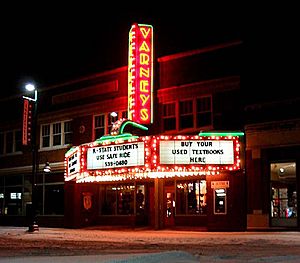
Aggieville is a lively area for shopping and nightlife. It has many stores, places to eat, and live music. Downtown Manhattan and the Manhattan Town Center Mall offer more shopping, art, and dining options.
The school year at Kansas State University greatly influences Manhattan's culture. Bill Snyder Family Football Stadium, Bramlage Coliseum, and McCain Auditorium host many events. These include national lectures and concerts. The Marianna Kistler Beach Museum of Art displays the university's art collection and visiting art exhibits.
Getting Around Manhattan
Airports for Travel
Manhattan Regional Airport (MHK) is about 4 km (2.5 miles) west of Manhattan. It is the second busiest commercial airport in Kansas. American Airlines' regional airline, American Eagle, offers daily flights to Chicago's O'Hare International Airport and the Dallas/Fort Worth International Airport. The airport also handles private and charter flights. Larger airports are in Kansas City and Wichita, Kansas.
Train Service
Passenger train service to Manhattan started on August 20, 1866. A main line of the Union Pacific Railroad still goes through the city. However, all passenger train service to Manhattan stopped after Amtrak took over in 1971.
Bus Services
You can travel by bus with Greyhound Lines. Inside Manhattan, general public transportation is provided by Riley County's ATA Bus service. ATA Bus started its first regular bus route in Manhattan in 2011.
Major Highways
Manhattan is served by several highways:

 I-70 / US-40 runs about 9 miles (14 km) south of Manhattan. Three exits connect directly to Manhattan.
I-70 / US-40 runs about 9 miles (14 km) south of Manhattan. Three exits connect directly to Manhattan.
- Exit 313 – K-177
- Exit 307 – McDowell Creek Road
- Exit 303 – K-18
 US-24 goes through Manhattan.
US-24 goes through Manhattan. K-177 runs north from I-70.
K-177 runs north from I-70. K-18 is an important road in Manhattan.
K-18 is an important road in Manhattan. K-113 (Seth Child Road) runs through the western parts of the city.
K-113 (Seth Child Road) runs through the western parts of the city.
Historically, Manhattan was on the Victory Highway, an early auto trail. In 1926, it became U.S. Route 40. In the 1950s, Route 40 was moved south of Manhattan. This was because of security concerns about the highway going through Fort Riley. The new route became Interstate 70 in 1956.
Media and News
The Manhattan Mercury is the city's main newspaper, published six days a week. Other newspapers include The Hype Weekly, which focuses on local events, and the K-State university newspaper, the Kansas State Collegian. Manhattan has had a newspaper since The Kansas Express started in 1859.
Manhattan is also a center for radio and TV. One AM and ten FM radio stations broadcast from the city. The first television station in Kansas, W9XAK, started in Manhattan on March 9, 1932.
Famous People from Manhattan
Many notable people have come from Manhattan, Kansas. These include famous writers, athletes, and leaders.
Sister Cities
Manhattan has one sister city:
 Dobřichovice, Czech Republic (since 2006)
Dobřichovice, Czech Republic (since 2006)
See also
 In Spanish: Manhattan (Kansas) para niños
In Spanish: Manhattan (Kansas) para niños



